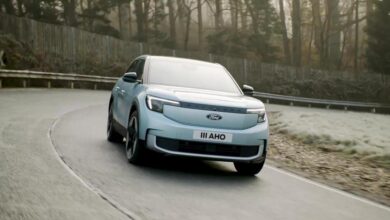Driving business EV adoption

Business EV adoption is continuing at pace as organisations push to meet ambitious carbon reduction and sustainability targets.
Emma Loveday, Senior Fleet Consultant at Volkswagen Financial Services (VWFS) Fleet, unpicks the incentives available for employers and employees to help drive the transition to electric vehicles. She also answers common questions about charging and helps businesses alleviate driver concerns.
Earlier this year, the UK hit a significant milestone in its sustainable transport journey; there are now over one million fully electric vehicles on UK roads.
Fuelled by technological advances, increasing consumer demand, and the widening availability of vehicle choices, the UK’s EV adoption has gathered significant momentum over the last few years, and this shift is also reflected in the business community.
In the past year, over 230,000 EVs have been added to business fleets as companies look to decarbonise their transport solutions. This is a 57% increase on the previous year.
The potential for cost savings, the need to comply with environmental legislation, and the array of attractive tax incentives for companies and drivers are all driving business EV adoption forward.
Yet, while the statistics show many organisations are already underway with their EV journey, some are falling behind. Businesses ultimately need to ensure their drivers are on board with the switch to stay on track and meet net zero targets. There are currently multiple incentives available to increase business EV adoption.
Reduced BIK contributions for EVs
For tax purposes, non-cash benefits are referred to as a benefit in kind (BIK). Employees will pay income tax at their marginal rate, based on the value of the BIK they receive. Employers will also pay national insurance contributions (NICs) based on the same BIK value.
For company cars, the BIK value is calculated based on the P11D list price of the vehicle, its CO2 tailpipe emissions and the employee’s income tax band. The tax rules for company cars are significantly weighted to incentivise and support the take-up of lower and zero-emission vehicles.
The employee BIK rate for EVs is currently fixed at 2% until April 2025. From this date, it will then increase by 1% each year until April 2028. As a comparison, the BIK rate for ICE vehicles is substantially higher, reaching as high as 37% for some vehicles with high CO2 emissions.
For example, an EV with a list price of £32,000 would attract a BIK of £644 per annum, or £54 per month, payable by the employee. Meanwhile, an ICE vehicle costing £25,900 could attract a BIK of £7,252 per annum or £604 per month – a significant increase in tax liability for the employee. The reduced BIK percentage attached to EVs also results in reduced NICs for the employer.
Salary Sacrifice schemes
Companies can also extend access to EVs to employees who don’t qualify for company car schemes through a car salary sacrifice scheme. This also helps businesses tackle their Scope 3 (indirect) emissions, which includes the emissions of vehicles owned and driven by employees for commuting.
At minimal cost to the employer, salary sacrifice schemes enable employees to ‘sacrifice’ a portion of their monthly salary (pre-tax) to fund a vehicle’s monthly lease payments.
This means employees who don’t qualify for a company car scheme can access a brand-new EV – with no upfront payment, no early termination fees and no hidden costs. This can make EVs more affordable and accessible for employees.
In addition to having access to a brand-new EV, employees will also see a reduction in the income tax and NICs they are required to pay, as the monthly payment is taken from salary pre-tax.
Vehicles in a salary sacrifice scheme have the same BIK rates as those in a company car scheme – so currently a low and very attractive rate of 2% for EVs.
For businesses, offering EVs through salary sacrifice schemes can reduce NICs, as employees’ taxable income will be lower. As such, the schemes can be a cost-effective way to optimise remuneration packages and improve staff retention.
Additionally, having employees drive brand-new, fully maintained vehicles reduces occupational road risks for the workforce required to drive for business purposes.
EV charging considerations
Alongside outlining the financial incentives available for employees when accessing EVs via company car or salary sacrifice schemes, businesses also need to tackle the common misconceptions around another crucial aspect of EV adoption: vehicle charging.
We’ve answered some of the most common questions around EV charging so employers can alleviate driver concerns.
How often is charging required?
Many drivers believe they need to charge an EV every night; however, for most people, this isn’t the case.
How often drivers need to plug in will depend on the range of the EV and the length of journeys. Given that most new EVs have a real-life range of over 200 miles and the typical daily mileage is in the region of 20 – 30 miles, most people will only need to charge up once or twice a week.
How long does it take to charge?
EV charging speed varies significantly between different makes and models. It also depends on the type of charger you’re using to charge.
For example, the Volkswagen ID.3 Pro can charge from 0-100% in 6 hours and 15 minutes using an 11kW home charger. Whereas, using an 82kW rapid charger on the public charging network, it can go from 10-80% in just 31 minutes.
Every EV has an individual charging capacity, which outlines how fast it can take on board the power to recharge the battery.
What will it cost to charge?
The cost to charge an EV depends on where it’s plugged in and the electricity tariff (£/kWh) being charged. This varies significantly, particularly when using the public charging network.
Assuming an average of £0.34/kWh for a standard home electricity tariff, it will cost around £17.00 to fully charge an EV with a useable battery of 50kWh.
Being able to access an off-peak home electricity tariff can significantly reduce the cost of charging an EV.
Public charging costs will be determined by the charging network, the type of charger and the applicable electricity tariff.
Apps like ZapMap can provide the current average price per kWh for different charging speeds on the UK network. In April 2024, this was 57p/kWh on slow/fast chargers and 80p/kWh for rapid/ultra-rapid chargers.
ZapMap suggests this equates, for an average efficiency EV, to 17 pence per mile and 24 pence per mile, respectively.
In addition to answering key driver questions about charging, to increase business EV adoption, companies can also highlight new initiatives to make the transition easier for their drivers.
This includes community charging schemes, where drivers without access to home charging can ‘rent out’ EV chargers from homeowners in their local area to bring down charging costs.
The extension of the government’s cross-pavement charging grant is also helping to extend the accessibility of home charging for drivers without access to off-street parking.
For businesses to meet ambitious net zero targets, the transition to EVs will play a significant role. However, getting drivers engaged and on board will help ensure a seamless transition.



